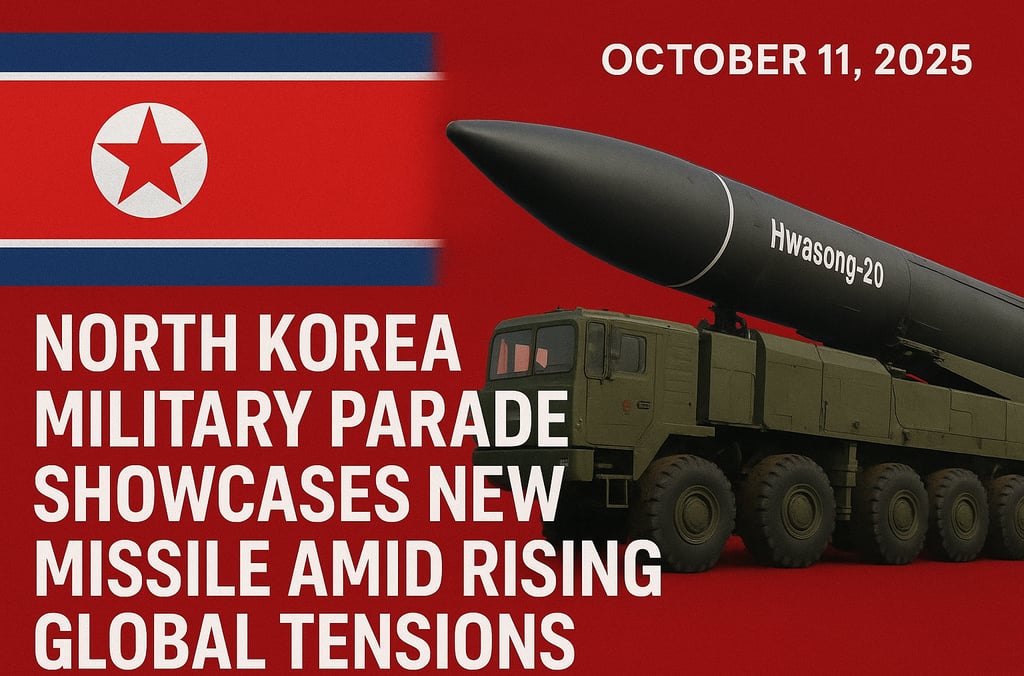North Korea Military Parade 2025 | Kim Jong Un Unveils Hwasong-20 Missile Amid Global Reaction
North Korea’s October 2025 parade unveiled the Hwasong-20 ICBM, sparking global concern and renewed tensions across East Asia
Raja Awais Ali
10/11/20252 min read


North Korea’s Military Parade Showcases New Missile Amid Rising Global Tensions — October 10–11, 2025
On October 10–11, 2025, Pyongyang held a large-scale military parade, once again drawing the world’s attention to North Korea’s expanding defense capabilities. The event marked the 80th anniversary of the ruling Workers’ Party and featured the debut of a new intercontinental ballistic missile, described by state media as the country’s most powerful “strategic nuclear weapon system.”
Supreme Leader Kim Jong Un delivered remarks emphasizing national sovereignty, defense modernization, and the need to strengthen deterrence against external threats. While his tone was firm, it remained focused on military preparedness and self-reliance.
Thousands of troops marched through Kim Il Sung Square, accompanied by tanks, armored vehicles, artillery, and drone formations. The highlight of the evening was the Hwasong-20 intercontinental ballistic missile (ICBM) — a next-generation system displayed on an 11-axle transporter-launcher, signaling enhanced mobility and strike capability.
Defense analysts noted that the missile’s design improvements suggest a shift toward solid-fuel propulsion, which would significantly reduce launch preparation time and increase survivability. However, this remains an analytical assessment, as North Korea has not officially confirmed the missile’s fuel type.
Images released by KCNA also revealed new drone models, hypersonic glide vehicles, and advanced multiple rocket launchers, underlining Pyongyang’s push toward modern, high-speed warfare technology. Among the distinguished guests were Chinese Premier Li Qiang, former Russian President Dmitry Medvedev, and Vietnamese leader To Lam, highlighting North Korea’s ongoing efforts to deepen ties with friendly nations despite strict international sanctions.
Reactions from global powers were swift. South Korea and Japan condemned the display as a “provocation” that threatens regional stability. The United States, led by President Donald Trump, called for an emergency security meeting with allies to review defense readiness in the Indo-Pacific region. The United Nations expressed “deep concern” over North Korea’s continued missile development and urged all sides to avoid escalation.
Military experts observed that the timing of the parade — amid global geopolitical uncertainty — reflects Kim Jong Un’s dual strategy: to project strength abroad while reinforcing domestic unity. Despite years of sanctions and diplomatic isolation, Pyongyang continues to expand its weapons programs with visible progress in missile and propulsion technologies.
The October 2025 parade was not just a ceremonial display — it was a calculated message to the world. Analysts believe North Korea aimed to showcase technological advancements, assert its deterrence capability, and signal that it remains a central actor in regional power dynamics. Satellite imagery and intelligence monitoring will determine in the coming weeks whether Pyongyang plans to test the newly revealed Hwasong-20 missile. For now, the international community remains on alert as tensions once again appear to be rising across the Korean Peninsula.